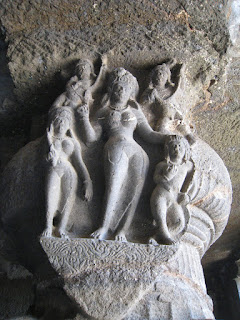

This is photo of a "Yakshini"(Yakshinis (Sanskrit: याक्षिणि, also called yaksinis or yaksis and yakkhini in Pali) are mythical beings of Hindu, Buddhist, and Jain mythology.)
A yakshini is the female counterpart of the male yaksha, and they both attend on Kubera (also called Kuber), the Hindu god of wealth who rules in the mythical Himalayan kingdom of Alaka. They both look after treasure hidden in the earth and resemble that of fairies. Yakshinis are often depicted as beautiful and voluptuous, with wide hips, narrow waists, broad shoulders, and exaggerated, spherical breasts.
In the Uddamareshvara Tantra, thirty-six yakshinis are described, including their mantras and ritual prescriptions. A similar list of yakshas and yakshinis is given in the Tantraraja Tantra, where it says that these beings are givers of whatever is desired. Although Yakshinis are usually benevolent, there are also yakshinis with malevolent characteristics in Indian folklore.
The earliest images of women in India are a set of Mauryan period figurines. These figures are not the first art objects to represent the feminine. Leaving aside the figures of the Harappan civilization which appear to be stylistically and culturally unconnected with anything in the historic period, there are terracotta images, believed to represent fertility or mother goddess figures. These are not images, they are symbols. They do not pretend to represent the physical impression of the female form.
The Mauryan figures are directly linked to these early fertility figures. The idea of producing an image of women in plastic arts clearly arose during the fourth and third centuries.
Only evidence for it comes from the region of Patna at the heart of the Mauryan Empire so it is assumed that the impetus probably came from the court artists of that period and locality, but we lack evidence to say for certain. The artists had several options in these early figures (fateful choices, as they would set the pattern for Indian female images for a millenia); they could copy the image of some other society, such as China, Greece or Iran; they could produce a naturalistic image from life; of they could modify a local tradition.
They choose the third. The Mauryan terracotta girls are the ancient fertility figures transformed from symbol to image. Large breasts, wide hips, tapering legs, are all retained but now the artists no longer symbolize the feminine, they now attempt to represent it.
1 comment:
Very well written post, thoroughly enjoyed it. Ellora Caves
is really amassing place. You can also check my post at Ellora Caves History at http://www.touristsafari.com/caves/ellora-caves
Post a Comment